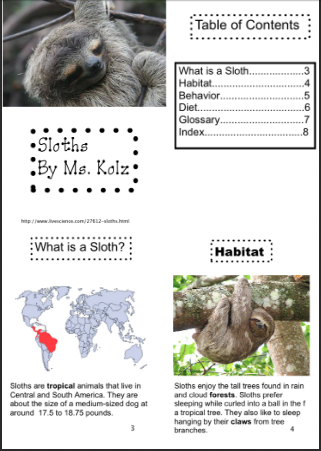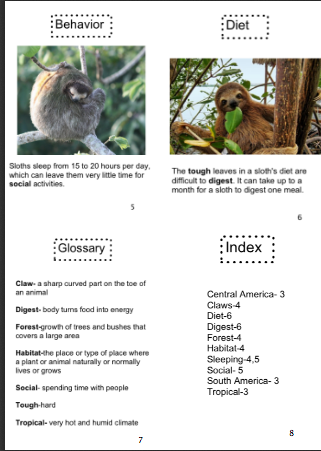Lesson- Text Features
- aakflygirl
- Mar 2, 2016
- 3 min read
Lesson Topic: Using a dictionary/ Glossary Subject: English/ Writing
IN Standards and Indicators: 1.RN.3.1 Know and use various text features (e.g., table of contents, glossary, illustrations) to locate and describe key facts or information in a text.
Lesson Objective: Students will be able to answer 3 out of 4 questions about a nonfiction text using a glossary, table of contents, and index.
Materials/Media:
What is already in class: whiteboards/ markers, pencil
What I am bring: sloth book for students, sloth book for me, books for scavenger hunt, nonfiction scavenger hunt sheet, Ms. Kolz book for me, Ms. Kolz book for students
Motivation: For motivation, I am going to start off by playing an ABC game. Every student will have a whiteboard. For this game, I will write four different words on the board and students are to put them in alphabetical order.
Game 1: Dog, Cat, Ball Answer: Ball, Cat, Dog
Game 2: Fox, Tiger, Wolf, Lion Answer: Fox Lion Tiger Wolf
Game 3: Train, Ship, Car, Bus Answer: Bus, Car, Ship, Train
*If at any time, students are misusing the whiteboards, they will be told to do the activities on paper.
Rationale: Today, boys and girls, we are learning about cool things that we can find in nonfiction text.
Teach:
Explaining:
For Motivation we played a game in putting words in alphabetical order. We did this because in nonfiction books all glossaries and index are put in alphabetical order. To help you find what you are looking for quickly
When explaining some features in Nonfiction on the floor.I am going to read the book titled Sloth that I wrote and point out key features. The students will each have a copy to keep as well.
These are the concepts being pointed out:
Title page- has the books author and title on it in the front of a book.
Table of Contents- Located at the front of a book, the table of contents displays a list of the big ideas within the book and where to find them.
An index is an alphabetical list of almost everything covered within the book, with page numbers. Readers can use the index to look up specific terms or concepts and go right to the specific information they're looking for.
- Located at the back of the book, a glossary contains key words that are related to the topic and their definitions. These definitions provide more information about new vocabulary words.
Review those terms before moving on
Check for understanding: Everyone flip your book to the glossary and hold it up. Next hold up table of contents page. Next hold up the Index. Who can tell me the definition of digest? What page can you find the word sleep?
Practice- The students will be completing a scavenger hunt around the classroom. The students will become detectives like we did for context clues. There will be various books around the classroom. Students will be able to work in pairs or by themselves. For this activity students will look at a book and will check of what the book has in the regards of glossary, table of contents, and index. This will give students the ability to view books that have all or some of the text features of nonfiction. Give the students 10 minutes to complete the task. A timer will be up on the board. At the end of the time all students must be in their seats quiet with their heads down. The goal I have in mind is to look at three different books in time or more.
Students are looking for:
Book Title
Table of Contents
Glossary
Index
If they like the book
Check for understanding: Since all these books were nonfiction, do all nonfiction books need a glossary? Do all nonfiction books have an index? Do all nonfiction books have a contents page? Raise your hands without talking if you found a book that interests you? Tell the people at your table about one of the books you looked at.
Assessment/ Evaluation of student learning- Students will show their understanding of using a glossary and a index by reading the book I made about Ms. Kolz. At the end of the book, students will be asked to answer four questions. If students need help, I will read the story to a select few on the floor then allow them to answer questions.
Review: Today boys and girls we learned about cool things that can be found in nonfiction text. What are some things in nonfiction text that we learned about? Do all books need to have all of them?


































Comments